The D-Lactate Free Probiotics Market is estimated to be valued at USD 49.9 billion in 2025 and is projected to reach USD 106.7 billion by 2035, registering a compound annual growth rate (CAGR) of 7.9% over the forecast period.
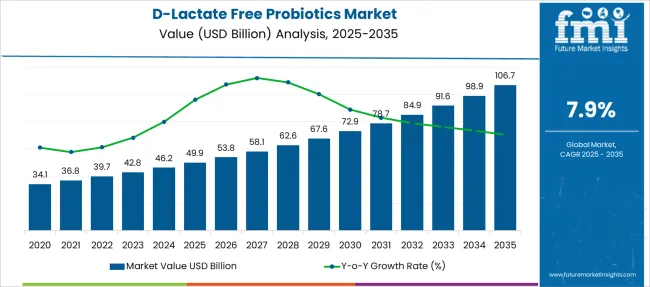
| Metric | Value |
|---|---|
| D-Lactate Free Probiotics Market Estimated Value in (2025 E) | USD 49.9 billion |
| D-Lactate Free Probiotics Market Forecast Value in (2035 F) | USD 106.7 billion |
| Forecast CAGR (2025 to 2035) | 7.9% |
The D-Lactate Free Probiotics market is expanding steadily as health-conscious consumers increasingly seek targeted microbial formulations that promote digestive safety and metabolic balance. Growing scientific consensus around the potential risks of D-lactate accumulation, especially in individuals with compromised gut integrity, has encouraged both manufacturers and healthcare professionals to advocate for D-lactate free alternatives.
This shift is being amplified by advancements in probiotic strain identification, encapsulation technologies, and regulatory frameworks favoring transparent labeling and strain-specific claims. Product innovation in functional foods, dietary supplements, and pediatric formulations is further driving the adoption of D-lactate free variants across both developed and emerging markets.
The market is also benefiting from clinical research linking gut microbiota modulation to broader systemic outcomes, including immunity, neurocognitive health, and inflammatory response management As a result, D-lactate free probiotics are being positioned not only as digestive aids but also as safe long-term solutions for vulnerable populations such as infants, the elderly, and patients with short bowel syndrome or chronic dysbiosis.
The market is segmented by Ingredient Type, Function, Application, and Distribution Channel and region. By Ingredient Type, the market is divided into Bacteria and Yeast. In terms of Function, the market is classified into Regular Use, Preventive Healthcare, and Therapeutics. Based on Application, the market is segmented into Food and Beverages and Dietary Supplements. By Distribution Channel, the market is divided into Hypermarkets/Supermarkets, Pharmacies/Drugstores, Specialty Stores, and Online. Regionally, the market is classified into North America, Latin America, Western Europe, Eastern Europe, Balkan & Baltic Countries, Russia & Belarus, Central Asia, East Asia, South Asia & Pacific, and the Middle East & Africa.
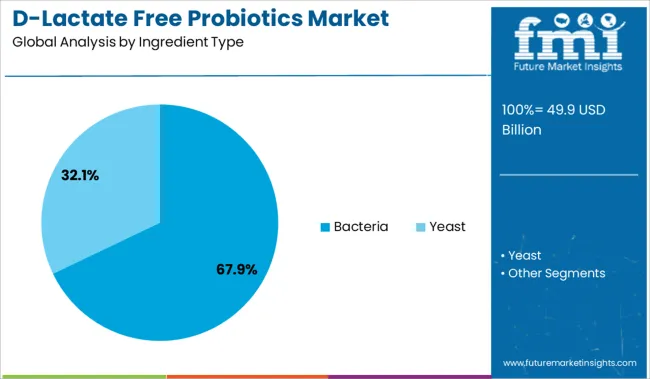
The bacteria segment is projected to account for 67.9% of the total revenue share in the D-Lactate Free Probiotics market in 2025, establishing it as the dominant ingredient type. The segment’s leadership is being driven by the extensive research supporting the efficacy and safety profile of specific bacterial strains that do not produce D-lactate during fermentation.
Increased adoption of bacterial probiotics such as Lactobacillus rhamnosus GG and Bifidobacterium lactis has been facilitated by their robust performance in maintaining gut flora balance without contributing to lactic acidosis. These strains are being incorporated widely in both clinical-grade and commercial probiotic formulations due to their resilience, shelf stability, and documented strain-specific health benefits.
The bacteria segment has also gained momentum from the ability to support encapsulated delivery systems, which protect viability and allow sustained colonization As awareness grows around the metabolic implications of D-lactate accumulation, the bacterial origin of probiotic ingredients continues to be favored by formulators seeking safe, effective, and scalable solutions.
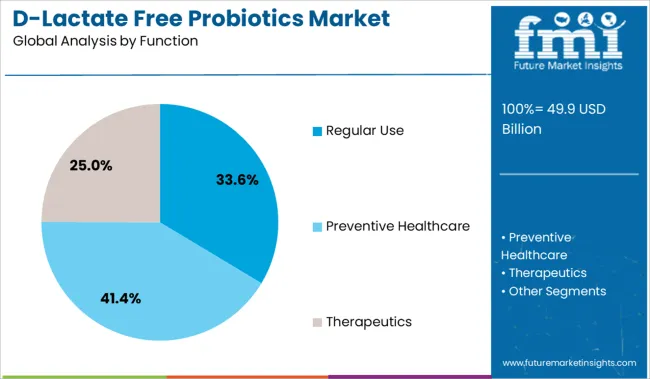
The regular use function segment is anticipated to represent 33.6% of the D-Lactate Free Probiotics market revenue share in 2025. This position is being driven by the increasing preference for probiotics designed for long-term, preventative consumption rather than short-term therapeutic interventions.
Consumers are incorporating these formulations into daily wellness routines to maintain gut homeostasis, support immune modulation, and prevent gastrointestinal discomfort without the risk of D-lactate buildup. The segment’s growth is further supported by product launches that position D-lactate free probiotics as safe for continuous intake across age groups, including children and the elderly.
Packaging innovations and labeling that emphasize daily use compatibility have also enhanced consumer confidence in adopting regular-use probiotics The rising influence of integrative medicine and lifestyle-centric health management has encouraged routine supplementation practices, reinforcing demand for microbiome-friendly solutions that are both effective and safe for habitual use.
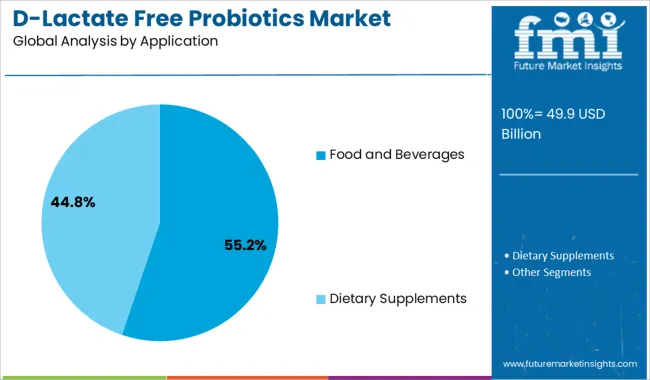
The food and beverages segment is expected to capture 55.2% of the D-Lactate Free Probiotics market revenue share in 2025, making it the leading application category. This dominance is being driven by the integration of D-lactate free probiotic strains into functional food products such as yogurts, smoothies, and plant-based dairy alternatives.
The trend toward daily, passive supplementation through everyday food consumption has led manufacturers to fortify widely consumed items with gut-friendly bacterial strains that align with clean label expectations. Advances in formulation stability and probiotic survivability under food processing conditions have enabled the incorporation of live cultures without compromising taste or texture.
As consumer demand grows for health-promoting convenience foods, D-lactate free probiotics are being positioned as value-adding ingredients for digestive safety and enhanced nutritional profiles The segment is also benefiting from endorsements by dieticians and regulatory encouragement for probiotics in school and clinical nutrition programs, reinforcing its long-term growth trajectory.
The D-lactate-free probiotics market has received a lot of traction in the industry.
Stakeholders can benefit from this growing awareness of D-lactate's potential health impact through D-lactate-free probiotic products.
The use of d-lactate-free probiotics is generally recommended for individuals who are diagnosed with autism, small bacterial overgrowth, or histamine issues. As patients receive more and more information about the health dangers of d-lactate and the health effects of d-lactate-free probiotics, more and more people are switching to d-lactate-free probiotics.
Increasing consumption of probiotic products, especially among those with mental health issues, balanced gut microflora, and treatments & prevention of certain digestive disorders, is augmenting growth in the probiotics market. A proliferating probiotic sector will further underpin the growth of d-lactate-free probiotics.
Dietary supplements and functional foods are gaining increasing traction due to their wide range of nutrition and health benefits. Probiotics market growth has been attributed to the rapid rise of consumer health concerns and awareness about the benefits of good microbes and gut health. Increased sedentary lifestyles, coupled with poor eating habits, are contributing to more digestive issues among the general population.
In response, many D-lactate-free probiotics manufacturers are focusing their efforts on short bowel syndrome, autism, and neurodevelopmental disorders in an attempt to grow sales of D-lactate-free probiotics. This is driving growth in the d-lactate-free probiotics market.
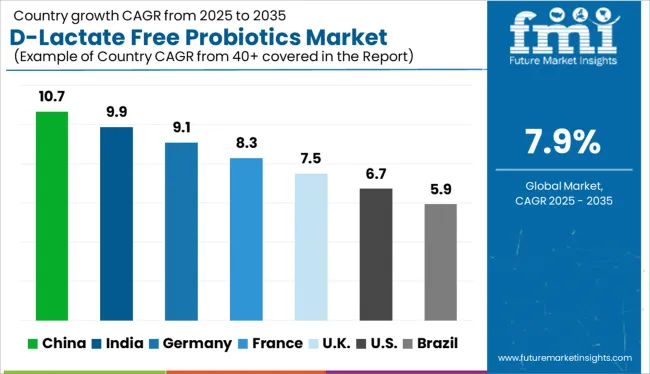
Creating opportunities for stakeholders in the D-lactate-free probiotics industry by raising awareness of the health risks caused by D-lactate
A proliferating probiotics industry will further sustain gains in the d-lactate-free probiotics market, with its multitude of health benefits, such as improved mental health, balanced gut microflora, and treatment and prevention of certain digestive disorders.
Over the forecast period, North America is expected to experience significant growth. Strong investment from the pharmaceutical and food and beverage industries is expected to contribute to the expansion of the d-lactate-free probiotics regional market.
The regional players are investing in D-lactate-free probiotics to create new products to cater to different age groups and genders. Such factors are expected to expedite the growth of the international d-lactate-free probiotics market over the forecast period.
Stakeholders are working on the development of temperature-stable bacteria that can be consumed without refrigeration or ice for a couple of weeks without losing any potency.
Furthermore, they are striving to make ingredients without gluten, sugar, soy, casein, dairy, yeast, flavors, preservatives, FOS, inulin, artificial colors, or any genetically modified ingredients.
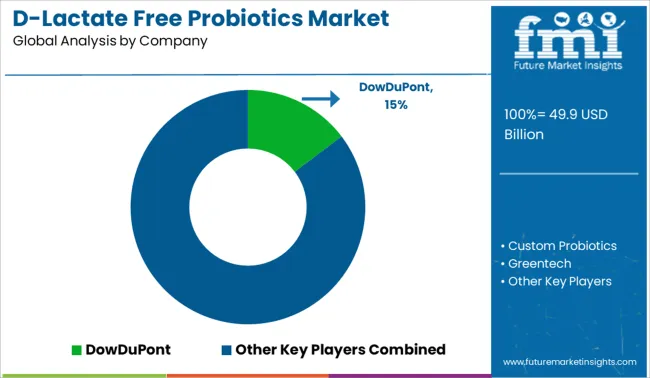
Some of the leading companies operating in the global D-lactate-free probiotics market include DowDuPont, Custom Probiotics, Greentech, Organic 3, Inc., UAS Laboratories, BioGaia AB, Danone, Sabinsa, Novozymes, Chr. Hansen, Yakult Honsha, Synbiotech, Nestlé, and Biosearch Life.
To meet the burgeoning demands of customers, manufacturers are creating custom probiotics, such as d-lactate-free products.
To take advantage of the growing competition in the probiotics market, companies are embracing unique strategies and integrating technology to develop unmatched, superior probiotics that promote physical and mental wellness, generating lucrative opportunities for the growth of the d-lactate-free probiotics market.
With its recent USD 100 million investment in a new probiotic fermentation plant, DuPont Nutrition & Health strives to extend its probiotics capacity by nearly 70%, as well as improve its leadership in clinically documented probiotics. With the new fermenting unit, the company intends to expand its probiotics capacity by nearly 70% and increase its leadership in probiotics research.
The Hansen Company, a global bioscience company, has formed a partnership with Prota Therapeutics, which develops oral immunotherapies to treat food allergies. Together, the two companies will study the best documented probiotic strain worldwide, LGG®, in Phase III clinical trial to develop alternatives to peanut allergies.
| Report Attribute | Details |
|---|---|
| Growth Rate | CAGR of 7.9% from 2025 to 2035 |
| Base Year for Estimation | 2024 |
| Historical Data | 2020 to 2024 |
| Forecast Period | 2025 to 2035 |
| Quantitative Units | Revenue in USD Million, Volume in Kilotons, and CAGR from 2025 to 2035 |
| Report Coverage | Revenue Forecast, Volume Forecast, Company Ranking, Competitive Landscape, Growth Factors, Trends, and Pricing Analysis |
| Segments Covered | Ingredient Type, Function, Application, Distribution Channel |
| Regions Covered | North America; Latin America; Europe; East Asia; South Asia; Oceania; Middle East and Africa |
| Key Countries Profiled | USA, Canada, Brazil, Mexico, Germany, United Kingdom, France, Spain, Italy, Russia, Poland, Australia, New Zealand, China, India, Japan, South Korea, Thailand, Malaysia, Vietnam, Indonesia, GCC Countrie, Turkey, South Africa, North Africa |
| Key Companies Profiled | DowDuPont; Custom Probiotics; Greentech; Organic 3, Inc.; UAS Laboratories; BioGaia AB; Danone; Sabinsa; Novozymes; Chr. Hansen,; Yakult Honsha,; Synbiotech, Nestlé; Biosearch Life |
| Customization | Available Upon Request |
The global d-lactate free probiotics market is estimated to be valued at USD 49.9 billion in 2025.
The market size for the d-lactate free probiotics market is projected to reach USD 106.7 billion by 2035.
The d-lactate free probiotics market is expected to grow at a 7.9% CAGR between 2025 and 2035.
The key product types in d-lactate free probiotics market are bacteria and yeast.
In terms of function, regular use segment to command 33.6% share in the d-lactate free probiotics market in 2025.






Full Research Suite comprises of:
Market outlook & trends analysis
Interviews & case studies
Strategic recommendations
Vendor profiles & capabilities analysis
5-year forecasts
8 regions and 60+ country-level data splits
Market segment data splits
12 months of continuous data updates
DELIVERED AS:
PDF EXCEL ONLINE
Freezer Label Market Size and Share Forecast Outlook 2025 to 2035
Freezer Liner Market Size and Share Forecast Outlook 2025 to 2035
Freeze Neutralising Kit Market Size and Share Forecast Outlook 2025 to 2035
Freeze Drying Market - Size, Share, and Forecast Outlook 2025 to 2035
Freeze Dried Fruit Powder Market Size and Share Forecast Outlook 2025 to 2035
Freeze-dried Food Market Analysis - Size, Growth, and Forecast 2025 to 2035
Freeze Dried Fruits Market Analysis - Size, Share, and Forecast Outlook 2025 to 2035
Freeze Drying Equipment Market Size and Share Forecast Outlook 2025 to 2035
Freezer Paper Market Size and Share Forecast Outlook 2025 to 2035
Freeze Dried Fruits And Vegetables Market Size and Share Forecast Outlook 2025 to 2035
Free-from Titanium Dioxide Market Size, Growth, and Forecast for 2025 to 2035
Freeze-Dried Vegetables Market Analysis - Size, Share, and Forecast Outlook 2025 to 2035
Freeze-Dried Pet Food Market Anlysis by Pet Type, Nature, Source, Process Type, and Sales Channel Through 2035
Freeze Dried Melt Market Analysis by Product Form, Fruit Type, Sales Channel, Packaging, , and Region Through 2035
Free Standing Display Units Market by Material & End-Use Forecast 2025 to 2035
Freezer Bags Market Growth, Trends and Demand from 2025 to 2035
Freestanding Large Cooking Appliance Market Trends - Growth & Forecast 2025 to 2035
Competitive Overview of Freeze Dried Fruits Market Share
Market Share Distribution Among Free Standing Display Units Providers
Competitive Breakdown of Freezer Paper Manufacturers

Thank you!
You will receive an email from our Business Development Manager. Please be sure to check your SPAM/JUNK folder too.
Chat With
MaRIA